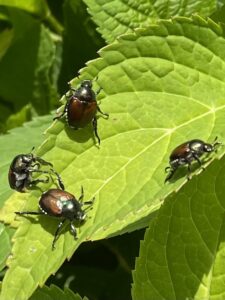Japanese Beetles
Here we are in the heat of summer, and I am busy preparing for battle…the battle to save my flowers, vegetables, and fruits. From what enemy you might ask?
The dreaded Japanese Beetle invasion…
 The Japanese beetle, as you might guess, is native to Asia but made its way over to Georgia and the states in the import of various organic materials. Not only does this beetle have a voracious appetite, but it also is not a picky eater in the least! From ornamental plants to fruit trees to your garden in the backyard, these pesky insects can devastate a landscape very quickly. My roses and grapevines seem to fare the worst and thus I personally concentrate my watchfulness on these two garden favorites in particular.
The Japanese beetle, as you might guess, is native to Asia but made its way over to Georgia and the states in the import of various organic materials. Not only does this beetle have a voracious appetite, but it also is not a picky eater in the least! From ornamental plants to fruit trees to your garden in the backyard, these pesky insects can devastate a landscape very quickly. My roses and grapevines seem to fare the worst and thus I personally concentrate my watchfulness on these two garden favorites in particular.
The adult beetles are actually beautiful. They have a shiny exoskeleton and are about half an inch long. They are iridescent and look green and bronze in color. They have a pair of hard wings called the elytra that only partially cover the body. If you happen to look closely enough (not me, no thanks) you will see six little tufts of whitish hair on the abdomen sides underneath the wings. Other beetles can look similar but this detail sets them apart from our similar but larger June bugs. Even though they can travel a long way, they look rather silly as they are a bit clumsy in flight.
When I mentioned that they will eat about anything, what I mean is that they eat a variety in the range of over 300 different types of plants. Again, not that picky. As it turns out, they do tend to have favorites though. My roses are among the top of the favorites list along with marigolds, crape myrtles, crabapple, and birch trees. You won’t have to wonder if you have Japanese beetle problems because the damage they leave behind is substantial and hard to miss. They will devastate the leaves of a plant due to eating the leaf lamina. This makes it look like a leaf skeleton is left behind. But they don’t stop there. The annoying little pests will eat the flowers and the fruit as well, sometimes eating up entire trees in their hunger. The adults start at the top because the leaves are more tender there being the newest growth. Mornings and early evenings are their typical feeding times. While the adults are busy consuming the leaves, flowers, and fruit, the larva (or grubs) attack the roots. This can make a plant look like it is in drought, or you will find wilted or discolored parts of the plant. The turf itself can start looking damaged and grow to become a visible injury to the area. Looking closely, you can find grubs near the root. And adding insult to injury, the circle of life issue shows up here when beetle grubs become food for destructive diggers like raccoons or armadillos. Can my garden get a break? And yes, I’m sure you know the armadillos are now found in North Georgia too. Welcome to Canton…I guess.
So what to do with this beetle problem we have here. Like most problems, early intervention is highly important. In the spring season and continuing into summer, I begin to watch my plants for damage. Believe me, it gets out of hand in a hurry so keep a watchful eye on your growing things. Some people like to put out beetle traps to monitor the presence of the Japanese beetle in certain areas; however, you should understand that the traps have not been shown totally effective at solving the problem or saving your beloved plants. Also, monitoring the soil for grubs around the planted areas can be helpful too.
Unfortunately, as an agricultural problem, we at Canton Termite do not offer services controlling the Japanese beetle. What we do recommend is getting in touch with your local county extension service for recommendations. They are a wealth of information and helpful advice in dealing with ornamental and garden pests.
Hopefully, this information will help you in the fight to protect your garden and lovely plants before this beetle wreaks havoc at your home.
Happy gardening from your family at Canton Termite and Pest Control!
By: Robin
